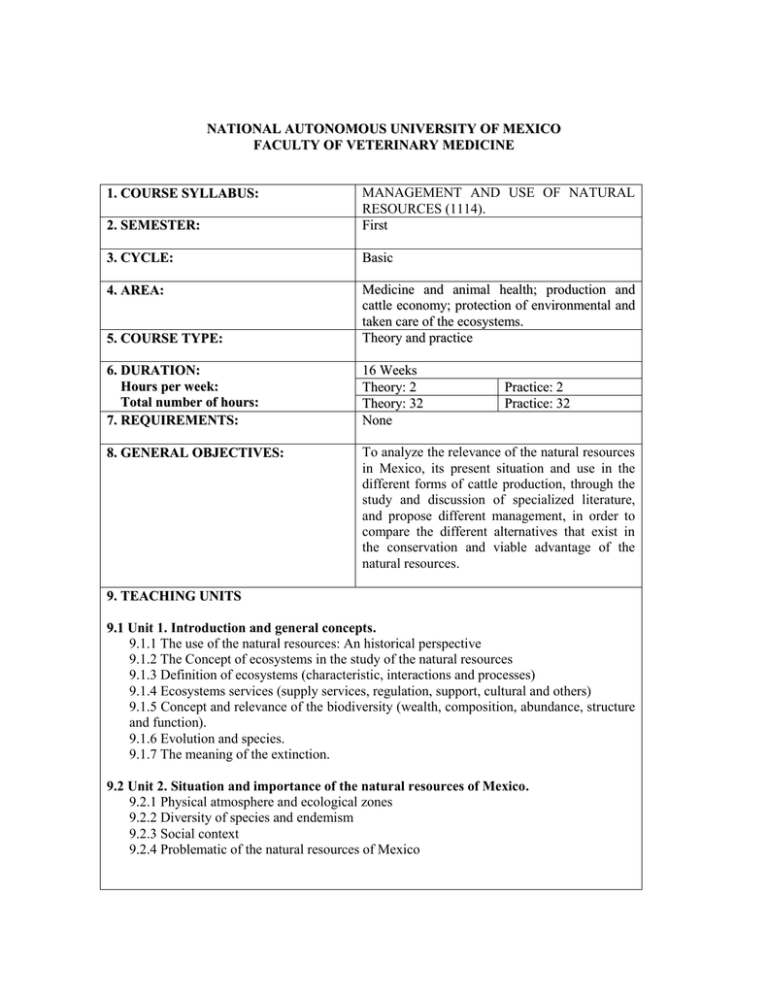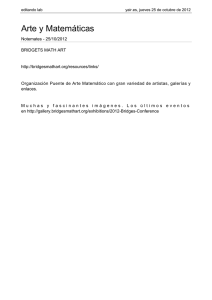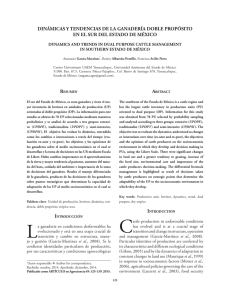MANAGEMENT AND USE OF NATURAL RESOURCES
Anuncio

NATIONAL AUTONOMOUS UNIVERSITY OF MEXICO FACULTY OF VETERINARY MEDICINE 2. SEMESTER: MANAGEMENT AND USE OF NATURAL RESOURCES (1114). First 3. CYCLE: Basic 4. AREA: 5. COURSE TYPE: Medicine and animal health; production and cattle economy; protection of environmental and taken care of the ecosystems. Theory and practice 6. DURATION: Hours per week: Total number of hours: 7. REQUIREMENTS: 16 Weeks Theory: 2 Theory: 32 None 8. GENERAL OBJECTIVES: To analyze the relevance of the natural resources in Mexico, its present situation and use in the different forms of cattle production, through the study and discussion of specialized literature, and propose different management, in order to compare the different alternatives that exist in the conservation and viable advantage of the natural resources. 1. COURSE SYLLABUS: Practice: 2 Practice: 32 9. TEACHING UNITS 9.1 Unit 1. Introduction and general concepts. 9.1.1 The use of the natural resources: An historical perspective 9.1.2 The Concept of ecosystems in the study of the natural resources 9.1.3 Definition of ecosystems (characteristic, interactions and processes) 9.1.4 Ecosystems services (supply services, regulation, support, cultural and others) 9.1.5 Concept and relevance of the biodiversity (wealth, composition, abundance, structure and function). 9.1.6 Evolution and species. 9.1.7 The meaning of the extinction. 9.2 Unit 2. Situation and importance of the natural resources of Mexico. 9.2.1 Physical atmosphere and ecological zones 9.2.2 Diversity of species and endemism 9.2.3 Social context 9.2.4 Problematic of the natural resources of Mexico 9.3 Unit 3. Protection and advantage of the biological resources in Mexico. 9.3.1 Foundations of biological conservation 9.3.2 Rational advantage of the natural resources in Mexico 9.4 Unit 4. Applicable laws and Norms in the protection and the advantage of natural resources. 9.4.1 Legal standardization for the protection and the advantage of natural resources in Mexico. 9.4.2 National legislation. 9.4.3 International legislation and agreements. 9.5 Unit 5. Impact of the cattle production in the natural resources. 9.5.1 History and development of the cattle industry in Mexico 9.5.2 General classification of cattle production and its present situation 9.5.3 Environmental challenges of the cattle activities and their cleaning 9.6 Unit 6. Environmentally viable options for cattle production. 9.6.1 Basic principles 9.6.2 Agrosilvopastoril production 9.6.3 Cattle ranch for self consumption and familiar production 9.6.4 The use of creole cattle 9.6.5 Diversification of the production and advantages in the integral use of the resources 9.7 Unit Practice activities. 9.7.1 Practice of laboratory calculation 9.7.2 Practice in an area with a rational use of natural resources 9.7.3 Practice in a industrialized cattle production unit. 10. BASIC BIBLIOGRAPHY 1. Miller, G.T. Ciencia Ambiental: preservemos la tierra. 5 ed. Thomson. 2002. 2. Hernández, L.: Historia ambiental de la ganadería en México. Instituto de Ecología, A. C., Xalapa, México, 2001. 3. Primak, R., R. Roíz, P. Feinsinger, R. Dirzo y F. Massardo: Fundamentos de Conservación Biológica, perspectivas latinoamericanas. Fondo de Cultura Económica, México D.F., 2001. Laws, regulations and norms: 1. Ley General del Equilibrio Ecológico y Protección al Ambiente (LEGEEPA) publicada en el Diario Oficial de la Federación el 28 de enero de 1998. 2. Ley General de Vida Silvestre publicada en el Diario Oficial de la Federación el 3 de julio de 2000. 3. Ley General de Desarrollo Sustentable publicada en el Diario Oficial de la Federación el 25 de febrero de 2003. 4. Reglamento de la LEGEEPA en materia de Áreas Naturales Protegidas publicada en el Diario Oficial de la Federación el 16 de noviembre de 2006. 5. Reglamento de la LEGEEPA en materia de Evaluación del Impacto Ambiental publicada en el Diario Oficial de la Federación el 16 de noviembre de 2006. 6. Reglamento de la LEGEEPA en materia de Auditoría Ambiental publicada en el Diario Oficial de la Federación el 16 de noviembre de 2006. 7. Reglamento de la LEGEEPA en materia de Ordenamiento Ecológico publicada en el Diario Oficial de la Federación el 8 de agosto de 2003. 8. Reglamento de la Ley General de Vida Silvestre publicada en el Diario Oficial de la Federación el 30 de noviembre de 2006. 9. Norma Oficial Mexicana “Protección ambiental -Especies nativas de México de flora y fauna silvestres- Categorías de riesgo y especificaciones para su inclusión, exclusión o cambio- lista de especies en riesgo” NOM-059-SEMARNAT-2001 publicada en el Diario Oficial de la Federación el 6 de marzo de 2002. Web pages: a) SEMARNAT www.semarnat.gob.mx b) Instituto nacional de ecología www.ine.gob.mx c) Comisión Nacional para el conocimiento y uso de la biodiversidad www.conabio.gob.mx d) PROFEPA www.profepa.gob.mx e) Programa de desarrollo rural sustentable www.fciencias.nam.mx/proders f) Convención sobre el comercio internacional de especies amenazadas de fauna y flora silvestres www.cites.org g) Unión mundial para la naturaleza www.sur.iucn.org h) Agroecología: Los retos de la actualidad www.geocities.com/SiliconValley/Way/4302/agroecologia.html i) Agroecología. www.agroecology.org/espanol.htm j) Centro latinoamericano de agroecología y desarrollo. www.clades.cl k) Revista de agroecología LEISA espanol.geocities.com/leisa_al/revista/index_rv.html l) Agroecología en acción México 2003. www.uady.mx/sitios/veterina/ofacad/curso_protropico/index.html 11. SUPLEMENTARY BIBLIOGRAPHY 1. Altieri, M., Nicholls C.: Agroecología: Teoría y práctica para una agricultura sustentable. Programa de las Naciones Unidas para el Medio Ambiente. México. 2000. 2. CONABIO.: La Diversidad biológica de México: Estudio de país 1998. Comisión nacional para el conocimiento y uso de la biodiversidad. México, D. F. 1998. 3. Cox, G.W.: Conservation ecology, biosphere and survival. WMC Brown Publishers, lowa, 2002. 4. Challenger A.: Utilización y conservación de los ecosistemas terrestres de México. Pasado presente y futuro. CONABIO, Instituto de Biología, UNAM y Sierra Madre A. C., México, D. F. 1998. 5. Daily, G. C. (Editor). Nature’s Services: Societal Dependence on Natural Ecosystems. Island Press, Washington, D. C. 1997. 6. Daily, G. C. and K. Ellison. The New Economy of Nature – The Quest to Make Conservation Profitable. Island Press, Washington, D. C. 2002. 7. De Haan, C., H. Steifeld y H. Blackburn: Livestock and the environment: Finding a balance. Comision of the European Comunities, FAO, World Bank, Suffolk, U.K. 2003. 8. Enkerlin H., E. C., G. C. Cano, R. A. Garza C., E. Vogel M.: Ciencia y desarrollo sostenible. International Thompson Editores, México, 1997. 9. Mackenzie, A.: Instant notes in ecology. Springer Verlag, New York, 1998. 10. Meffe, G.K., Carroll, C.R.: Principles in conservation biology. Sinauer Publishers, USA. 1994. 11. Ojasti J.: Utilización de la fauna silvestre en América Latina: Situación y perspectivas para un manejo sostenible. FAO, Roma, Dept. 1993. 12. Ondarza, R.N.: Ecología: El hombre y su ambiente. Trillas. México 1993. 13. Reid, W. V. and about 27 other authors. Ecosystems and Human Well-Being: Synthesis, A Report of the Millenium Ecosystem Assessment. Island Press, Washington, D.C. 2005. 14. Smith, R. L., Smith, T. M. Ecología. 4a Ed. Addison Wesley, Madrid, España. 2001. 15. Takuya A., Simon A., Masahiko H.: Biodiversity: an ecological perspective. Springer Verlag, New York, 1996. 16. Toledo, V.M.; Carabias, J.; Toledo, C. y González-Pacheco, C.: La producción rural en México: Alternativas ecológicas. Fundación Universo Veintiuno, México 1993. 17. Trujillo J. et al.: Ecología aplicada a la agricultura: Temas selectos de México. UAM Xochimilco México, 1996. 18. Voght G., Wargo, V.: Ecosystems, balancing science with management. Springer Verlag, USA, 1997. 19. Exposition of the professor with tags, exposition 12. TEACHING METHODOLOGY with brain storm, cases study and group discussion. Commented readings, demonstrative practices, problems solution, practical exercises, and projects proposals. 13. COURSE EVALUATION Written tests, evaluation of practices, tasks, projects, homework, and participation in classes. 14. REQUIREMENTS FOR TEACHING THE COURSE Veterinarian or animal science degree, specialist in the use and advantage of natural resources and/or wild animals, or 5 years of experience in these areas.

